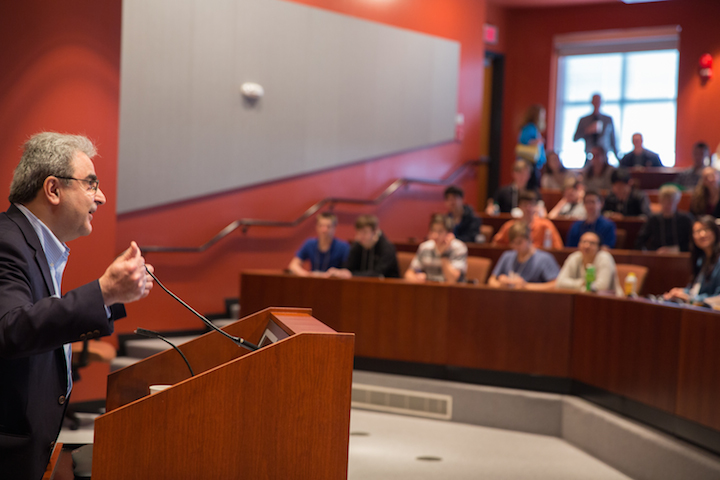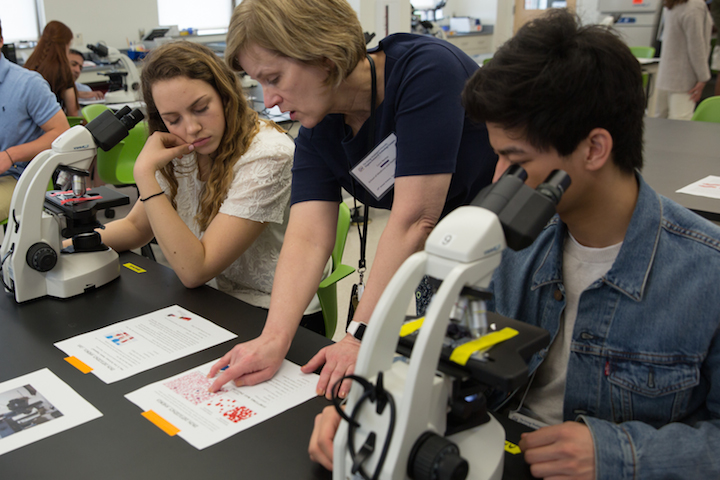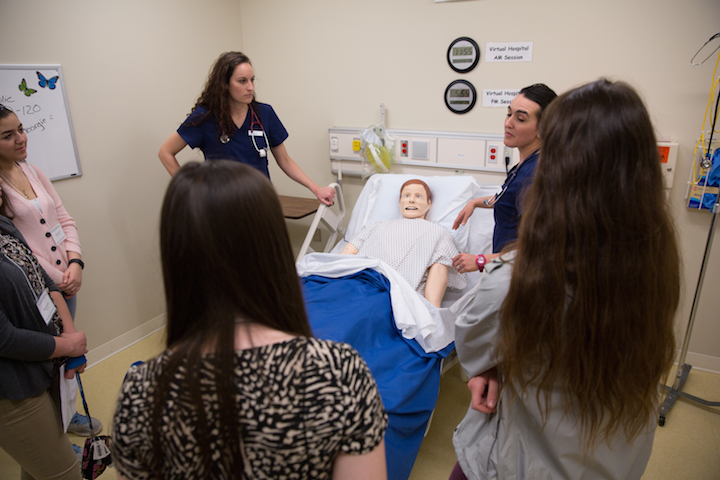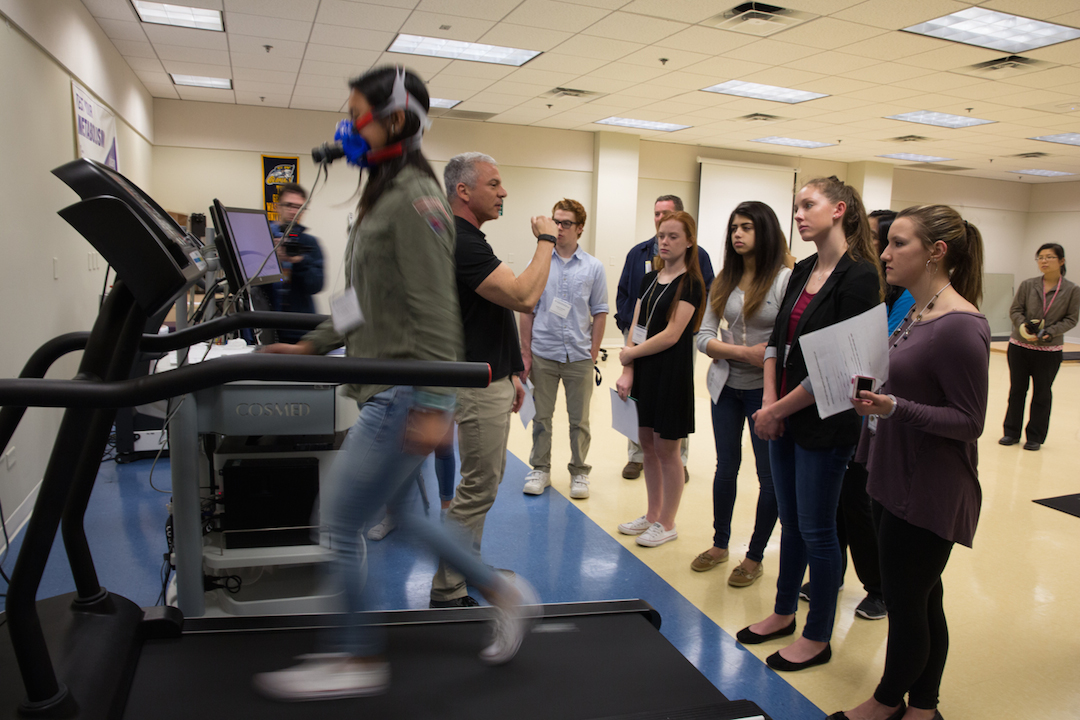By Kevin Dunleavy
If the primary objective of the George Washington University’s Science, Technology and Engineering Day was to show high school students that it’s cool to follow their inner Einstein, then it couldn’t have found a better keynote speaker than Jason Osborne.
Introducing himself as someone who “transformed my career based on what I love,” Mr. Osborne, a paleontologist and geologist, showed a Discovery Channel clip of his “extreme diving” exploits, claiming 20-million-year old whale bones from the bottom of the Dismal Swamp.
He also discussed developing weapons systems for the U.S. military. And he showed a video of how he developed a craft beer using yeast from the bones of fossils.
If a successful, restless, rugged thrill-seeker like Mr. Osborne is a science nerd, then it’s definitely cool to be one.
Mr. Osborne was just one of the highlights of the 10th annual event at GW’s Virginia Science and Technology Campus on Thursday. Featuring sessions hosted by schools and departments across the university, STE Day included 133 students and their teachers from 12 high schools in Loudoun County who participated in a variety of hands-on workshops.
 Ali Eskandarian, dean of the Virginia Science & Technology Campus, provides welcoming remarks to Loudoun County students and teachers. (William Atkins/GW Today)
Ali Eskandarian, dean of the Virginia Science & Technology Campus, provides welcoming remarks to Loudoun County students and teachers. (William Atkins/GW Today)
‘Aha moments’
From the School of Engineering and Applied Science, students got an understanding of the dynamics of drone flight by controlling quadrotors. They also explored an automobile outfitted with cutting-edge instrumentation that provides a safer driving environment.
To learn about the physics of projectiles, students built launchers that shot ping pong balls, an exercise that was full of “aha moments,” according to Maryann Skrzycki, a physics teacher at Park View High School.
“Students got to build something with their own hands, and they had to think,” she said. “Physics is challenging because students have to apply math skills in the science lab, which they haven’t had to do before. Each problem involves different critical-thinking skills, so students have to reason out how to solve the problem. This was a great example of that.”
Students set up experiments with high-speed cameras, getting an understanding of how scientists use them along with lasers to learn about complex fluid flows, which can unlock secrets about global warming and the behavior of a nuclear reactor core during earthquakes.
Neil Hansberger, a physics teacher at Stone Bridge High School, was particularly inspired by what he saw in the fluid dynamics demonstration, hoping to use a piece of what he saw in his classroom.
“It’s like, I can go write a grant so I can get this piece of equipment, which would be an extremely valuable learning tool for my students,” Mr. Hansberger said. “I’ve only had something like that happen here.”
 Hands-on workshops hosted by 10 GW schools and departments addressed topics ranging from cyber crime and fluid dynamics to DNA fingerprinting and genetic analysis. (William Atkins/GW Today)
Hands-on workshops hosted by 10 GW schools and departments addressed topics ranging from cyber crime and fluid dynamics to DNA fingerprinting and genetic analysis. (William Atkins/GW Today)
From cyber crime to DNA analysis
At a cyber crime workshop hosted by the College of Professional Studies, a computer screen was all that was needed to show students how tech-savvy criminals gain access to information.
When the instructor guided students to a security camera in Heidelberg, Germany, Emily Wilson, a junior at Dominion High School, gasped when she discover that she could pan the camera herself.
“I was very surprised that you can get into security cameras from around the world,” Ms. Wilson said. “Cyber security is definitely a field that’s going to expand. I think it’s an area I’d like to work in because our country could be very vulnerable to outside sources.”
In an herbal medicine workshop, students experimented with plant compounding, discovering how to create medicinal therapies for healing wounds, pain relief and skin regeneration from garden plants and household items.
Across the hallway, in a new wet lab in Discovery Hall, other students peered into microscopes, learning how medical lab science can have a profound impact on patient care.
In another lab hosted by the School of Medicine and Health Sciences, students isolated their own DNA in a test tube and learned basic techniques in DNA fingerprinting, sequencing and genetic analysis.
“It was cool that you’re able to extract DNA and see it in such a pure form,” Ms. Wilson said.
 Nursing students demonstrate the capabilities of GW's simulation lab, which includes beds for 10 patients, populated by static and mid-fidelity mannequins that simulate patients from infants to the elderly. (William Atkins/GW Today)
Nursing students demonstrate the capabilities of GW's simulation lab, which includes beds for 10 patients, populated by static and mid-fidelity mannequins that simulate patients from infants to the elderly. (William Atkins/GW Today)
Measuring athleticism
Amid all the mental exercise, there was physical activity as well.
In a Milken Institute School of Public Health workshop that examined the science of training an elite athlete, cross country runner Alexa Gomez, a junior at Broad Run High School, ran on a treadmill while hooked up to a heart monitor. Associate Professor Todd Miller explained how he could determine Ms. Gomez’s maximum work rate.
A few feet away, Fahim Islam, a cross country runner at Park View, got his vertical jump measured (25.1 centimeters). Then holding five pounds of plastic “fat,” he jumped 22.6 centimeters, demonstrating how excess weight can hinder an athlete’s performance.
Bryanna McDermott, a junior soccer player at Heritage High School, was thrilled to discover that her body fat was significantly less than average at 19.5 percent and was fascinated by the breakdown.
“I found it interesting that my legs were much more lean than the rest of my body, especially my right leg, my dominant leg,” she said.


